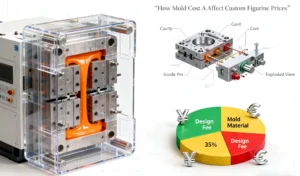Introduction: Why Mold Costs Matter in Custom Figurine Production
If you’ve ever wondered why custom figurines (Art Toys, mini figures, or Blind Box Figures) can vary so much in price, you’re not alone. One of the biggest factors behind these differences is the mold cost — the starting point of any mass production process.
Whether you’re producing soft vinyl toys, resin statues, or plastic collectibles, understanding how molds are made and priced will help you control your costs, plan production more effectively, and avoid surprises later on.
💬 “Wait, why does one prototype cost hundreds, while mass production seems cheaper?”
Let’s break it down step by step.
1. The Basics: What Is a Mold and Why It’s Essential
A mold is the mother tool that forms your figurine’s shape — every detail, texture, and curve you designed is transferred through this mold.
Different materials require different mold-making techniques:
- Silicone molds for resin casting molds — ideal for small batches or prototypes.
- Soft plastic molds or rotational molds for vinyl figures.
- Injection molds for ABS or PVC plastic figurines — perfect for mass production.
Each of these has unique costs, advantages, and applications, which we’ll explore next.
2. Mold-Making Methods and Their Cost Range
1️⃣ Silicone Mold Making (for Resin Figures)
Silicone molds are widely used for resin figurines, art toys, and limited editions.
They’re flexible, easy to produce, and allow high detail accuracy.
Cost range:
- Small figure (under 10 cm): around $100–$300 per mold
- Larger or more complex figure: $300–$800
However, silicone molds wear out after dozens of casts — meaning they’re not suitable for large-scale production.
Keywords: silicone mold making, silicone molds for resin, resin mold, resin casting molds
2️⃣ Resin Transfer Molding (for High-End Resin Collectibles)
Resin transfer molding uses a harder mold and a pressurized system to create denser, more durable resin figures.
It’s a preferred method for high-end collectibles and statues.
Cost range:
- Complex mold with multi-parts: $1,000–$3,000
- Ideal for runs of 50–200 pieces
This process produces smoother finishes and stronger details than silicone molds, but setup cost is higher.
3️⃣ Soft Plastic and Vinyl Rotational Molds
Soft vinyl (rotocast or “sofubi”) figures are made using rotational molding with aluminum or steel molds.
These molds must withstand heating and spinning processes to ensure even wall thickness.
Cost range:
- Small toy mold: $1,500–$4,000
- Large complex figure mold: $5,000+
Because of the equipment and process involved, vinyl molds are more expensive upfront but ideal for runs of hundreds or thousands of figures.
4️⃣ Injection Molding of Plastics (for ABS or PVC Figures)
If you’re creating mass-market toys, action figures, or Blind Box Figures, you’ll need injection molding.
Plastic mold (ABS/PVC):
- Made from hardened steel or aluminum
- Highly durable — can produce thousands to millions of pieces
Cost range:
- Simple mold: $3,000–$6,000
- Complex figure mold (multi-cavity, movable joints): $8,000–$20,000+
Injection molding is costly upfront, but the unit cost per figurine becomes extremely low as production increases.
Keywords: plastic mold, injection molding of plastics, mini figures, blind box figure
3. Why Batch Size Changes the Unit Price
This is where the math gets interesting.
When you order just one custom figurine, you bear the full mold cost. But when you order hundreds or thousands, that same mold cost spreads across all units.
For example:
| Batch Size | Mold Cost | Unit Mold Cost per Figure |
|---|---|---|
| 1 piece | $500 | $500 each |
| 50 pieces | $500 | $10 each |
| 500 pieces | $500 | $1 each |
So when you see that “the more you make, the cheaper it gets,” it’s not just a saying — it’s basic manufacturing economics.
💬 Tip: Always plan your production quantity early. Even small adjustments can save thousands in the long run.
4. Key Considerations Before You Start Mold Production
Here are some expert tips before you begin your mold-making process:
✅ Choose the right material:
Don’t use ABS molds for soft resin — you’ll waste money and time.
✅ Optimize your prototype:
Slightly simplifying the sculpt can save hundreds on mold cost.
✅ Ask about reusability:
Some molds (like resin molds) can be reused with minor modifications for new versions.
✅ Consider future scaling:
If your figurine sells well, you might upgrade from resin to PVC injection molding — plan this ahead.
5. Hidden Costs: What Many Beginners Overlook
Even if your mold price is confirmed, there are still other factors:
- Prototype and test shot fees
- Painting & finishing molds
- Packaging molds (especially for Blind Box Figures)
- Maintenance and storage costs
All these can slightly affect your final figurine unit price, especially for small runs.
6. Final Thoughts: Invest Smart, Scale Wisely
In the world of custom figures and collectibles, your mold is not just a cost — it’s an investment.
A well-made mold ensures precision, consistency, and efficiency, which ultimately defines the quality of your brand.
If you’re still unsure whether resin molds, vinyl molds, or plastic injection molds fit your project
or
📩 Contact our engineering team for a free mold evaluation.
Email:stella@newmiho.com
Website: https://newmiho.com/




